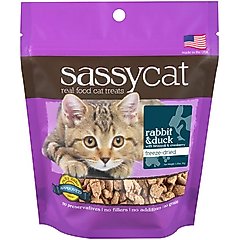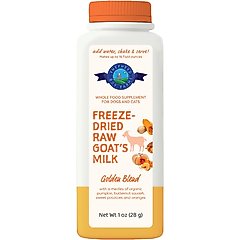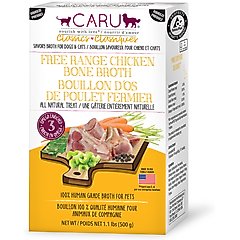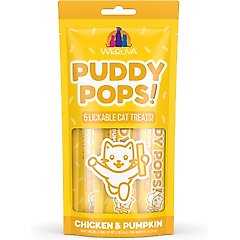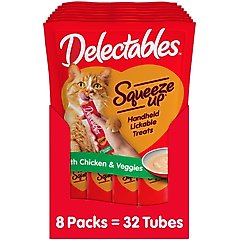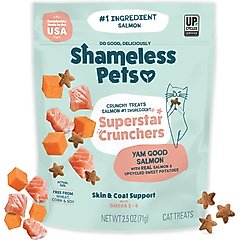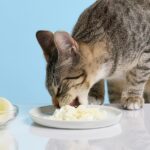What Vegetables Can Cats Eat? 11 Veggies Safe for Cats
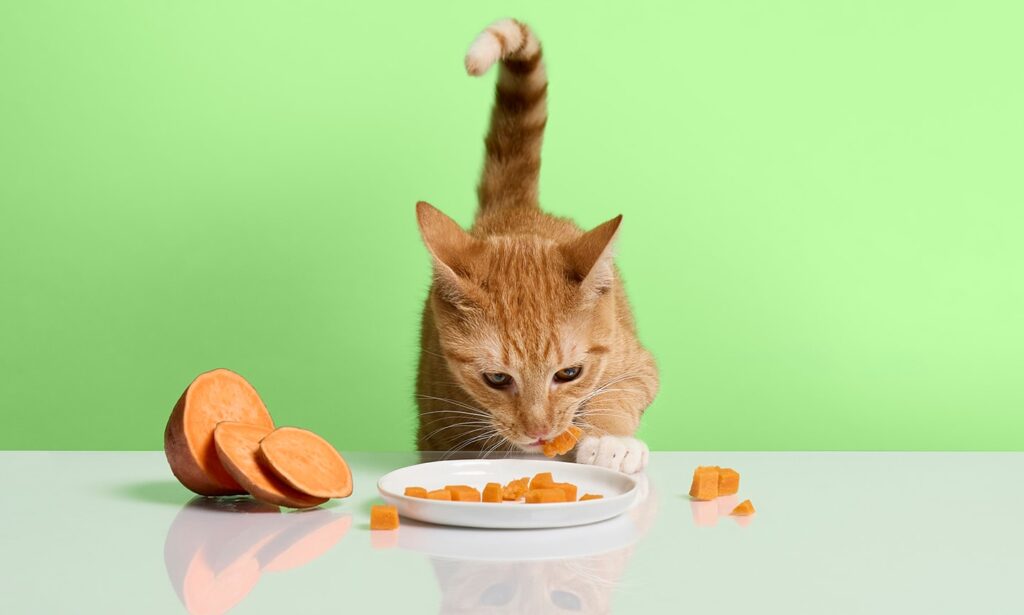
Photo by Chewy
Cats are obligate carnivores (meaning cats eat meat to survive), and a cat’s diet should generally be high in protein and fat. But that doesn’t mean your cat can’t enjoy the occasional vegetable treat! In fact, adding a few cat-safe vegetables in small quantities to your kitty’s regular diet can provide a few health benefits.
So, what vegetables can cats eat? Learn all about cats and vegetables, the health benefits of these veggies, and the best way to feed them to your cat. We’ve also listed 10 veggies your feline friend should never have.
Before introducing any new food into your cat’s diet, always check with your veterinarian.
Can Cats Eat Vegetables?
Cats can eat vegetables, but they don’t need them to be healthy. Because cats are obligate carnivores, they get most of their nutrition from meat-based food.
But if your cat is poking around your salad, you can give them some vegetables as a treat. That said, veggies should be served in moderation, making up no more than 10% of the total calories of your cat’s daily diet, with the rest coming from a complete and balanced cat food.
What Vegetables Can Cats Eat?
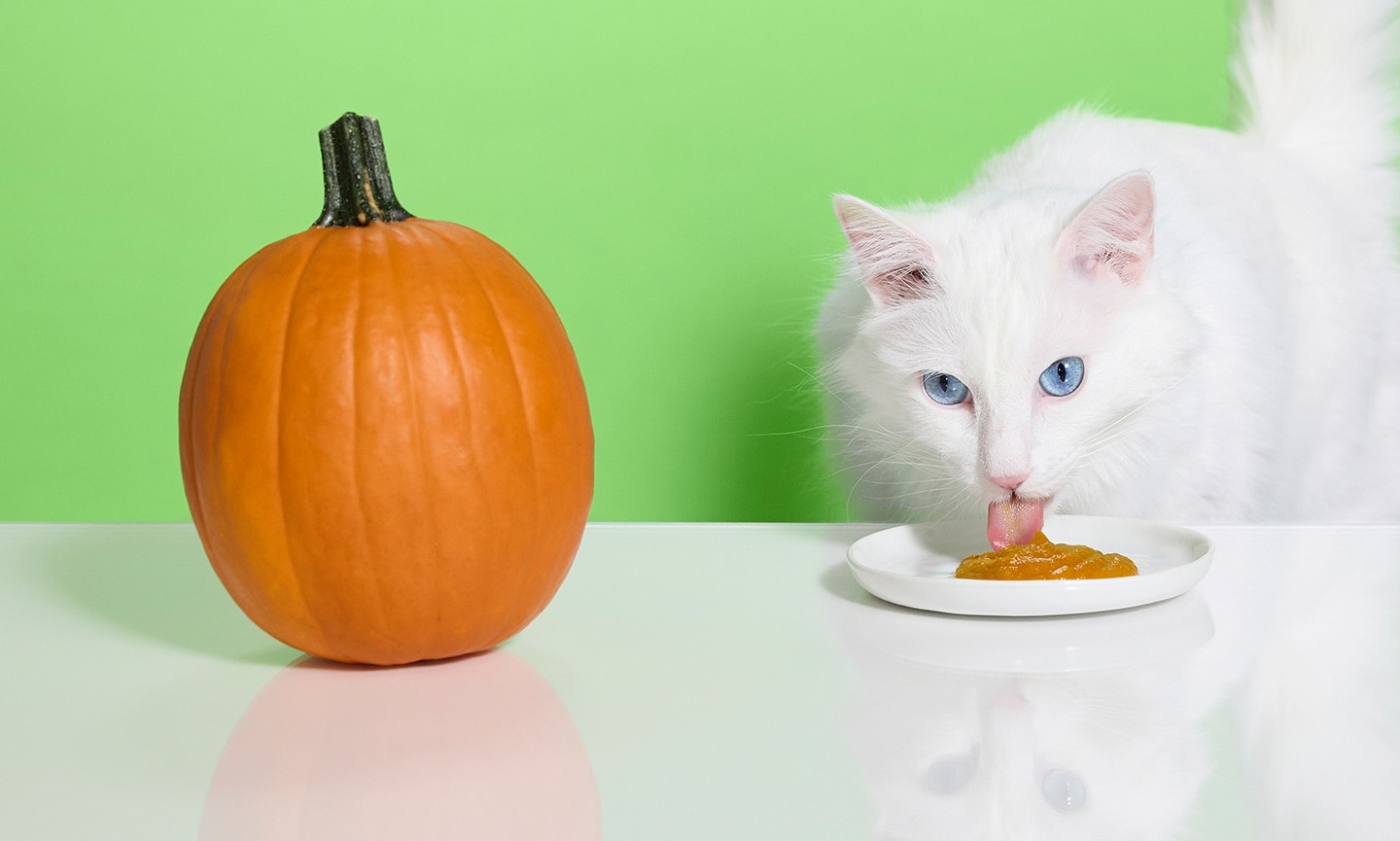
Photo by Chewy
The following are cat-safe vegetables that also provide some health benefits.
Asparagus
- Health benefits: Good source of fiber, folate, vitamin C, vitamin A, and vitamin K; low in calories, which makes it a good treat option for overweight cats
- How to prepare: Cut off the tough ends of the stalks, wash, then steam or boil until soft. Cut into bite-size pieces.
- How much to serve: 1–2 teaspoons one to two times per week
Broccoli
- Health benefits: High in fiber and antioxidants; good source of vitamins C and K
- How to prepare: After washing, remove stems and cut florets into small pieces; steam or roast
- How much to serve: 1–2 small bites (about a teaspoon’s worth) one to two times per week
- Our favorite cat treat with broccoli: Herbsmith Sassy Cat Rabbit & Duck with Broccoli & Cranberry Freeze-Dried Cat Treats
Recommended Product
Butternut Squash
- Health benefits: High in fiber, vitamin A, vitamin C, and potassium; can reduce inflammation and help support a healthy digestive system
- How to prepare: Peel and scoop out seeds; cut into small cubes and steam for 15 minutes, then mash or puree.
- How much to serve: 1 teaspoon one to two times per week
- Our favorite cat treat with butternut squash: Shepherd Boy Farms Raw Goat’s Milk Golden Freeze-Dried Cat Treat
Recommended Product
Carrots
- Health benefits: Low in calories and high in fiber; contain beta-carotene, which can help promote healthy vision
- How to prepare: Wash and peel, then cut into bite-size pieces. Steam, boil, or bake until soft.
- How much to serve: 1–2 small pieces one to two times per week
- Our favorite cat treat with carrots: Bocce’s Bakery Crispy Chikn & Carrot Cat Treats
Recommended Product
Celery
- Health benefits: High in fiber, which can help with constipation; high water content that contributes to hydration; contains vitamin A, vitamin C, vitamin K, potassium, and calcium
- How to prepare: Wash thoroughly, remove tough strings, and cut into bite-size pieces.
- How much to serve: 1–2 pieces one to two times per week
- Our favorite cat treat with celery: Caru Free Range Chicken Bone Broth Cat Food Topper
Recommended Product
Green Beans
- Health benefits: Good source of fiber, vitamin C, and vitamin K; low-calorie, low-carbohydrate option that can help support weight loss
- How to prepare: Wash and cut into bite-size pieces. Serve raw, or steam or boil until soft.
- How much to serve: 1–2 1/4-inch small pieces one to two times per week
Peas
- Health benefits: Good source of fiber and protein; contain vitamin A, vitamin B, and vitamin K; can help promote digestive health and a healthy coat
- How to prepare: Wash and serve raw, frozen, or steamed. If frozen, let thaw slightly before giving them to your cat.
- How much to serve: 2–3 peas one to two times per week
Pumpkin
- Health benefits: Good source of fiber, vitamin A, and vitamin C; can help with diarrhea and constipation; contains an antioxidant called lutein, which promotes eye health
- How to prepare: Cut off the top and scoop out the seeds, then roast until soft. Scoop out the flesh and puree or mash.
- How much to serve: 1–2 teaspoons one to two times per week; if your cat is constipated, your vet might recommend you feed them pumpkin daily
- Our favorite cat treat with pumpkin: Weruva Puddy Pops Chicken & Pumpkin Grain-Free Lickable Cat Treats
Recommended Product
Spinach
- Health benefits: Contains many nutrients, including vitamin A, vitamin C, vitamin K, riboflavin, calcium, magnesium, potassium, and folate
- How to prepare: Wash and steam, then chop before serving.
- How much to serve: 1 teaspoon one to two times per week
- Our favorite cat treat with spinach: Hartz Delectables Squeeze Up Chicken & Veggie Lickable Cat Treats
Recommended Product
Sweet Potatoes
- Health benefits: Good source of vitamin A and vitamin C; high in fiber and potassium
- How to prepare: Wash and peel, then boil until soft. Mash or puree in a blender.
- How much to serve: 1 teaspoon one to two times per week
- Our favorite cat treat with sweet potatoes: Shameless Pets Yam Good Salmon & Sweet Potato Crunchy Cat Treats
Recommended Product
Zucchini
- Health benefits: High in water and fiber, which can help with constipation; rich in vitamin A, vitamin C, magnesium, potassium, and manganese; helps promote a healthy immune system
- How to prepare: Wash, then steam or roast until soft. Cut into bite-size pieces before serving to your cat.
- How much to serve: 1–2 small pieces one to two times per week
What Veggies Can Cats Not Eat?

Photo by Chewy
Not all human foods are cat safe. While there are plenty of vegetables cats can eat, others are no-gos because they can make your cat sick.
If your cat eats any of the following vegetables, call your veterinarian or the Pet Poison Helpline (855-764-7661; a fee applies) for guidance on what to do next.
- Chives: Chives are part of the allium family of vegetables, which contain toxic sulfur compounds that can damage red blood cells.
- Garlic: Garlic also belongs to the allium family and is three to five-times more toxic than onions.
- Green (unripe) tomatoes: Unripe tomatoes contain a toxic compound called solanine that can cause vomiting, diarrhea, tremors, and seizures.
- Leeks: Leeks are also part of the allium family and have toxic sulfur compounds.
- Onions: While onions aren’t as toxic as garlic, they’re still part of the allium family and should be avoided.
- Raw potatoes: Like unripe tomatoes, raw potatoes contain solanine and can lead to serious health issues.
- Rhubarb: Rhubarb contains oxalate crystals and oxalic acid, which can cause tremors, drooling, and kidney failure.
- Scallions: Another member of the allium family, scallions should also be avoided.
- Shallots: Shallots are similar to onions and belong to the allium family, so they can damage the red blood cells.
- Wild mushrooms: Many wild mushrooms are toxic to cats and can cause severe health problems, like kidney and liver damage. While all wild mushrooms aren’t toxic, there’s no good way to differentiate, so you should avoid them all. If your cat eats a wild mushroom, take a photo of the top, bottom, and stem to help poison control identify the plant and the appropriate next steps.
FAQs About Cats and Vegetables
Q: Is it OK for cats to eat vegetables every day?
A: Yes, if your cat really enjoys veggies, they can eat them in moderation daily—as long as they don’t exceed 10% of their total calorie intake.
Q: When should cats eat vegetables?
A: You can offer vegetables one to two times per week, mixed into their regular food, or as a treat alternative. Because cats are obligate carnivores, they don’t need vegetables to be healthy, though.
Q: Can cats eat raw vegetables?
A: Some cats can eat raw veggies, but many vegetables are easier to digest when cooked.
Always wash veggies thoroughly to remove pesticides or other chemicals before feeding them to your cat.
Q: Can vegetables replace meat in a cat’s diet?
A: No, vegetables can’t replace meat in a cat’s diet. Cats are obligate carnivores, which means they need plenty of protein and other nutrients, like taurine, that aren’t in plants.
Attributions
Expert input provided by Bethany Hsia, DVM, co-founder of CodaPet; Michael Thompson, DVM, founder and leading veterinarian at Pets Food Safety; and Sarah Wooten, DVM, a veterinary educator.
This content was medically reviewed by a veterinarian.
